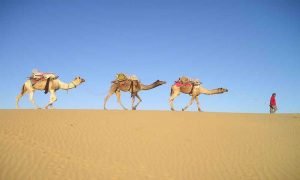Economic Impact of Tourism: All standard impact analysis related to tourism considers the direct, indirect and induced impacts related to flows of money occurring due to tourist spending. The direct effects are called the primary impact of tourism while the indirect and induced impacts are called the secondary impact of tourism.
The total economic impact of tourism is the sum of direct, indirect and induced effects of tourism occurring in a region. Economic impact of tourism is most generally measured in terms of sales, revenues, employment or additional value generated on account of tourist activity.
You may read about Tourism Product Life Cycle

1. Direct Impact of Tourism
The direct impact of tourism is noticed mainly in the primary sectors such as hotels and lodging, restaurants, transport, entertainment and retail. Direct impact refers to the changes occurring in sales, job generation, tax revenues and income accruals due to changes in tourism expenditure patterns.
More number of tourists staying in hotels will increase sales and revenue accruals in the hotel sector. These increased sales and related changes in wage / salary payments, tax revenues, demands for goods and services are the direct impacts of more tourists spending.
Read more on Aviation Industry in India
The direct impact of tourism may be illustrated through a simple example. If a particular area attracts an additional 100 tourists daily each of who spends Rs. 100 every day. That translates into an increase of Rs. 10,000 when a tourist spends daily in the area. Over a 100 day period, this translates into 1 million rupees of additional spending which is distributed across hotels, lodges, restaurants, entertainment and shopping or retail sectors.
About 30% of the million rupees would transit outside of the area to cover the cost of supplies procured and these are not manufactured or produced in the area. The balance Rs. 7.0 lakhs in sales can yield Rs.3.5 lakhs of income to the direct tourism sector and generate 20 direct jobs. It may be inferred that the direct impact of tourism is to induce income and employment, converting a large percentage of sales into direct income and employment.
Read more about Transportation in India
2. Indirect Impact of Tourism
The indirect impact of tourism refers to the changes that result due to re-spending of the primary tourism sectors in backward linked sectors. Through its indirect impact, tourism has the potential to impact almost every sector of the economy. The indirect impact of tourism may be illustrated by extending the example quoted in the direct impact section as follows.
Also read on Tourism Product Concept
The primary tourism sectors comprising hotels, restaurants etc., buy goods and services from other businesses in the region. Against Rs. 7 lakhs of income, some of the Rs.3.5 lakhs is paid out as salaries and wages to the workforce. In addition, part of the Rs.7 lakhs income is spent in procuring goods and services from other businesses. Each of these businesses is additionally linked to other vendor partners and suppliers.
This in turn creates a secondary impact in the area. If each rupee of direct sale generates another rupee of secondary sales, Rs. 7 lakhs of direct sales results in Rs.1.4 million of total sales. In this way, secondary sales generate additional income and employment resulting in a hypothetical total of Rs. 1.4 million of sales, Rs.6.5 lakhs of income and 35 jobs. In this way, the primary sectors of the tourism industry are linked indirectly through different degrees to other economic sectors in the area.
Read more on Aviation Industry in India
3. Induced Impact of Tourism
Induced impact of tourism refers to changes in economic activity primarily reflected in changes in household spending of income earned either directly or indirectly from tourism. The workers in hotels, restaurants, retail shops and their associated suppliers and partners are paid wages out of spending incurred directly or indirectly through tourism.
These employees in turn spend their wages on housing, food, transport and other goods and services required for their daily needs. The sales, income and jobs that get generated from such household related spending of tourism employee wages are the induced effects of tourism. In this way, secondary tourism comprising indirect and induced impacts can in effect, impact almost every sector of the economy in one way or the other.
You may read about Tourism Product Life Cycle
The magnitude of the secondary impact will be very large if primary tourist businesses purchase goods and services mainly from local suppliers. The impact on induced effect is mainly felt when primary sector tourism service providers are shut down. Not only are the supporting businesses and industries impacted but the entire local economy suffers a slowdown because of reduction in household incomes in that area.
Also read on Tourism Product Concept
Retail shops generate fewer sales as consumers leave the area in search of jobs or to purchase goods and services. Conversely, an opposite induced impact is observed when the primary tourism sectors are able to generate large sales due to increased tourism spending.
4. Other Economic Impacts of Tourism
There are other economic impacts of tourism that do not fall under the direct, indirect and induced categories. These are discussed below.
Read more on Aviation Industry in India
Impact on Prices: Tourist activity, especially during the ‘tourism season’ can artificially inflate prices of hotel rooms, in restaurants and retail shops in the area
Impact on Quality / Quantity of Goods / Services: Tourism can trigger a wider variety of goods and services to become available in an area. The quality of these goods and services can be higher or lower than without tourist activity.
You may read about Tourism Product Life Cycle
Impact on Property Taxes / Other Taxes: More tourist activity can lead to higher levels of taxation with businesses being taxed more heavily for the tourist infrastructure and services that will have to be put in place such as roads, bridges, provisioning for electricity and water.
Social and Environmental Impacts: Tourism can have both positive and negative social and environmental impacts in the area. For example, more tourists will result in more traffic and this can result in more air pollution. Improved amenities can result in more elderly person or a variety of businesses to relocate to an area changing its social demography and characteristics.
Also read on Tourism Product Concept
5. Final Demand. Another concept related to the economic impact of tourism is that of ‘final demand’. Final demand refers to sales to end users of goods and services which invariably refer to households. Government spends and investments in an area that may also be considered in terms of final demand.
For example, tourism demands for parks and facilities can lead to government spending on such infrastructure to satisfy the needs of the end users. Figure 5 captures final demand on account of tourism.
Concepts of Tourism Multipliers and Multiplier Effects
Multipliers indicate the secondary economic impact of tourism including indirect and induced effects. In other words, multipliers are used as only the secondary impact of tourism must be analysed. They refer to the economic interdependencies of sectors occurring within the economy of an area.
Read more on Aviation Industry in India
They vary depending on which secondary impacts are being considered and whether the economic measures of sales, income or employment are being considered. For example:
• Type 1 Sales Multiplier = (Direct + Indirect Sales) / Direct Sales
• Type 2 Sales Multiplier = (Direct + Indirect + Induced Sales) / Direct sales
When a direct sale is multiplied with a type 1 sales multiplier, the direct and the indirect sales are obtained. When a direct sale is multiplied with a type 3 multiplier, the total impact of tourism in sales including direct, indirect and induced impacts are indicated. These multipliers are called ratio based multipliers as they consider the ratio of total impact to direct impact.
Also read on Tourism Product Concept
While the above example indicates the ‘sales’ economic multiplier, comparable multipliers can be obtained for income and employment measures as well. Another method of calculating multipliers is to compute a ratio of income / employment to sales. For example;
• Type 3 Income Multiplier = (Direct + Indirect + Induced Income) / Direct Sales
• Type 3 Employment Multiplier = (Direct + Indirect +Induce Income) / Direct Sales
The income or employment multiplier when multiplied by the direct sales indicates the impact of tourism on employment.
You may read about Tourism Product Life Cycle
Measurement of Economic Impact of Tourism
The economic impact of tourism can be measured through any variation of the following basic formula.
Economic Impact of Tourism = (No. of tourists X Average Tourist Spending X Multiplier) Based on this formulate, the economic impact of tourism may be measured through the following sequential steps.
Read more about Transportation in India
Estimating the Number of Tourists Who Visit an Area
There are currently no models that can accurately measure the numbers of tourists visiting a particular region. Nor are there models that can accurately predict or estimate changes in tourist footfalls or which can separate the local population from tourists.
Also read on Tourism Product Concept
Hence the accuracy of the estimate rests on statistical projections or good judgement. The best way to measure the average numbers of tourist footfalls is to conduct long-term surveys that measure how many tourists visit a particular region over a longer period of time like a year.
Estimating Average Tourist Spending
Average spending by tourists may come from surveys or from other studies made in the region. In general, accurate estimates of average tourist spending must be based on representative samples of the total tourist population that considers changes in tourist types, locations and seasons.
Read more on Aviation Industry in India
Spending can vary greatly amongst different types of tourists. Hence estimates on average tourist spending can be obtained by averaging spending from each tourist segment and by taking spending of about 100 tourists from each tourist segment.
Segmentation achieves the key objectives of understanding differences between local people and tourists, between day tourists and overnight visitors, type of accommodation they stay in (hotel, lodges, homes of friends and relatives) and kind of transportation used (car, bus, rail, air etc.).
You may read about Tourism Product Life Cycle
Once such segmentation has been achieved, the spending occurring within each segment can be ascertained. Some researchers prefer to focus on spending patterns of tourists who visit a region for very specific activity such as skiing or boating or mountaineering etc.
Multiplying the number of tourists obtained in the first step with the average spending amount per tourists gives an estimate of the total tourists spending occurring in that area. The estimated tourist spending captures the amount of income that tourists generate within a region and is a measure of the direct impact of tourism.
Read more about Transportation in India
Estimating Secondary Impact
The secondary impact of tourism may be estimated using multipliers. These multipliers may be obtained from economic or input / output models of the area’s economy. Multipliers are also available from research / published studies conducted on the economic potential of the area.
However, for any particular region it is important to use a multiplier that has been derived from studies related to that region alone. Else the secondary impact of tourism will be erroneous. In general, if an area is large and has a more diversified economy it will have a larger multiplier than smaller regions with less development.
Applying country or state wise multipliers to a particular region will lead to inflated estimates of secondary impact. The advantage of using multipliers is that they can be used to convert direct sales into estimates of income and employment that gets generated per rupee of sale.
Read more on Aviation Industry in India
Identifying Key Factors in Conducting an Economic Impact Study of Tourism
Information on the key concepts related to the economic impact of tourism and hospitality for users to conduct such economic impact analysis in their respective regions, to interpret and apply the results. Hence it is important to understand some of the key factors related to an economic impact analysis of tourism. These are summarized as follows:
• Define the Actions whose economic impact have to be evaluated
• Identify changes in tourism activity that can potentially result on account of the action
• Identification of Spend Categories to be considered in the impact analysis
Also read on Tourism Product Concept
• Define the Study Region
• Identification of Key Economic Sectors
• Identify the most important measures of economic activity
• Accuracy of Results







Pingback: houston junk car buyer